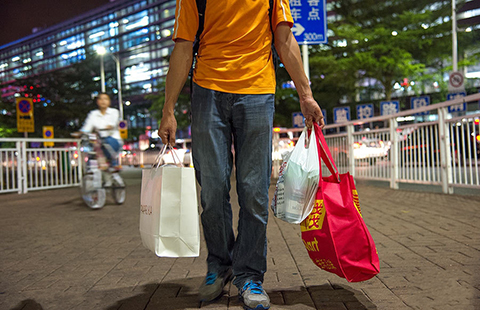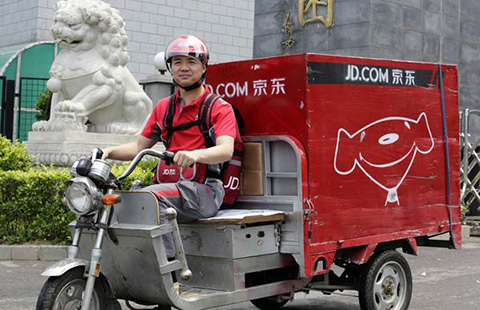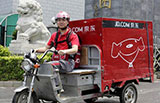China buys from world at home
(Xinhua) Updated: 2015-10-19 09:18Almost every afternoon, Cao Fushun goes to a nearby express delivery station to see if any parcels have arrived for him. The retired worker has caught the "haitao" bug.
For Cao, haitao (buying overseas goods online) means he can shop from countries he has never previously heard of.
Living in Pengzhou, a county near Chengdu, capital of Sichuan province, Cao has bought skimmed milk from Australia, beef from Argentina, and a water filter from Germany, among other foreign goods.
At the end of last year, Cao's daughter, an accountant in Beijing, bought US-made fish oil capsules and vitamin tablets for her parents. "I was surprised how inexpensive they were, so I got hooked on haitao myself," she said.
A fast growing number of Chinese online shoppers are buying globally. Most are digital natives, young, well-educated and eager to buy foreign goods that are unavailable or exorbitantly priced in China. There is a booming multi-billion-dollar market for foreign e-retailers and producers.
According to China E-commerce Research Center, the country's total cross-border e-commerce-inbound and outbound-reached 4.2 trillion yuan ($657 billion) in 2014, and will grow to 5.5 trillion yuan by the end of this year.
The Ministry of Commerce forecasts that cross-border e-commerce will be worth 6.5 trillion yuan in 2016, accounting for 20 percent of the country's total foreign trade.
Nielsen's Global E-commerce and New Retail Survey in April said several factors are at play to boost China's e-commerce. Rapid urbanization and high population density make the home delivery model economically viable, particularly when coupled with low labor costs. In addition, booming smartphone ownership and usage have created huge mobile commerce opportunities.
China's domestic e-commerce sector is gaining its share of the market too. According to the customs service and China E-commerce Research Center, 18 million Chinese spent 140 billion yuan on haitao in 2014. The haitao market volume is expected to reach 1 trillion yuan in 2018.
The government is backing this trend. In August 2013, the State Council issued a policy to support cross-border e-commerce, with six measures to facilitate processes, including customs clearance, quarantine inspection, duties and foreign exchange.
In 2014, seven cities-Shanghai, Hangzhou, Ningbo, Zhengzhou, Guangzhou, Shenzhen and Chongqing-were designated as import e-commerce pilot zones, where foreign goods can be stored in bonded warehouses before customs clearance. In 2015, another two coastal cities were added to the list.
According to tax regulations in those cities, each order under 500 yuan is duty-free, and each order from 500 to 1,000 yuan incurs a 10 percent tariff, compared with ordinary imported goods being taxed around 40 percent on average.
Some pilot cities have also simplified their customs regulations. In Guangzhou, e-retailers can immediately register overseas goods with customs when a Chinese buyer makes a deal, so tariff collection and other procedures are faster.
Under Guangzhou's system, discount retailer Vip.com completed customs clearance for 800 watches in just 40 minutes.
On Nov 11, 2014, at the 22nd APEC Economic Leaders' Meeting in Beijing, the APEC Cross Border E-Commerce Innovation and Development Initiative was launched to support the trade.
For e-commerce giant Amazon and its competitors, including NYSE-listed Alibaba Group Holding Ltd, new opportunities have emerged since last year.
On Aug 20 last year, Amazon China announced it would begin cross-border online shopping in the China (Shanghai) Pilot Free Trade Zone. Chinese buyers could go to Amazon websites in the US and other countries to buy online and receive shipments in a week to 10 days with lower delivery costs.
Amazon has tactically changed the "proxy" mode of overseas online shopping, whereby a Chinese buyer pays a proxy to buy goods abroad, and the proxy dispatches the goods as personal items.
The proxy mode has several risks, such as fake goods provided by the proxy, delivery delays, and documentation and tax issues during customs clearance. If all goes smoothly, a shipment by air from the US can arrive in one month, or 20 days from Europe, and 10 days from Japan.
Amazon's bonded warehouses mode is easier and cheaper. With the help of data collected over the years, Amazon can forecast orders and send goods in advance by sea to Shanghai free trade zone's bonded warehouses. Amazon the sends the items from Shanghai after a Chinese buyer makes a purchase.
Big players in China's e-commerce sector, such as Alibaba and NASDAQ-listed 360buy, have followed Amazon to open haitao channels. They cooperate with foreign retailers to sell seafood from Alaska, avocados from Mexico, or even one-million-yuan jetpacks designed in New Zealand. Many e-commerce firms also use bonded warehouses to import mass consumption goods like infant formula powders, diapers, vitamin pills and cosmetics.
Moreover, Alibaba uses its global payment system, Alipay, to bring in more players from abroad, including US retailing giants Macy's, Bloomingdale's, Saks Fifth Avenue and Neiman Marcus, and luxury brands like Prada and Hugo Boss.
Chinese consumers can log on to foreign retail websites and pay in renminbi through Alipay, which includes duties and delivery costs. Then they wait a week or two to receive the goods, which can be tracked online.
Chen Fengying, head of the World Economy Research Center of the China Institute of Contemporary International Relations, believes haitao will boost the world economy and create jobs abroad.
- Chinese public companies expect rising 3Q profits
- FedEx chief unveils new strategy
- HK's dispensaries new attraction for mainland visitors
- TsinKaz reveals sauce of its success
- Riding high on coral red wave
- Confidence back on hopes of reforms
- Bond issuances hit a record high
- Right time for wearable devices

















